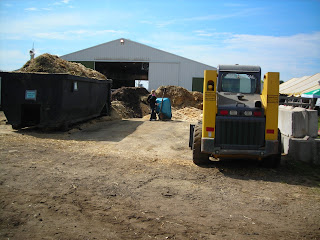 |
| Move that manure! |
I know my grandfather was one of those gardeners who waited
until around Memorial day to plant so I guess adding that manure in April would
have given it time to age enough that it wouldn’t burn the plants. And back
then people didn’t worry so much about salmonella and other manure carried
pathogens. Or maybe the manure was well aged when it was delivered, I don’t
remember.
Any manure you add to flower beds should be well aged, so it
won’t burn plants. (Well-aged is manure that’s several months old.) The burn effect comes from both an
overabundance of nutrients such as nitrogen and the actual heating up of the
manure as it decomposes. Plants will turn yellow and brown and can quickly die
if too much fresh manure is applied near them.
Rabbit and goat manure is not as likely to burn plants even
when applied fresh. But it will contain lots of pathogenic bacteria. Poultry
manure is probably the worst manure for “burning” plants when fresh. Manure
from other animals falls somewhere between.
Aged manure may not burn the plants, but it can still carry
bad bacteria. It’s debatable whether we have more problems with salmonella,
listeriosis, and other food borne pathogens than we did fifty years ago. But we
are more knowledgeable about the diseases they cause. Manure in food gardens
should be applied long before the garden is planted, preferably several months
before, to prevent bacterial contamination. This is especially true for root
crops and leafy greens.
Manure is less likely to change soil pH than common
fertilizers, it improves soil structure as it provides lots of organic matter,
especially if mixed with animal bedding, and it usually is high in
nitrogen. Manure improves soil
aggregates, the way soil sticks together, which lessens erosion and makes a
better place for plant roots.
Manure is great for the compost pile and composted manure
and bedding mixtures makes an excellent soil amendment. But, it’s an
inefficient way to supply plant nutrients. Unless you have it tested, you don’t
know what nutrients the manure actually provides. What type of animal produced
it, what it ate, what bedding the manure is mixed with, how long the manure was
stored and how it was stored all effect the nutrient content of manure.
There are other drawbacks to manure. Manure increases soil electrical conductivity,
which helps soil hold on to mineral elements. Some of these are salts, which
over time, can build up in the soil and harm plants. If manure washes off it
can run into surface water, contaminating it.
And it can even contaminate ground water in certain circumstances. Don’t
apply manure on slopes or close to bodies of water, ditches, or drains. Keep it 50 feet away from any wells.
In recent times some manure may contain chemicals that harm
plants. These were applied to hay the
animals ate and are excreted in manure. And manure often has lots of weed
seeds, especially if it came from horses. A horse’s digestive system moves food
through it so quickly that many weed seeds survive the journey. Horses consume
weed seed both from pastures and from hay.
The best time to apply manure to flower beds, perennial
crops and the vegetable garden is after the plants are dormant and the ground
cold, but preferably not frozen. You could apply 6-8 inches of manure if you
have it. If manure is applied before perennial
plants are dormant, they may start growing again and that new growth will be
winter killed, wasting plant resources.
Manure applied to frozen ground is more likely to run off
nutrients which contaminate nearby water. And if the ground is frozen the
nitrogen in the manure will largely disappear before the spring thaw. Adding
3-4 inches of manure before the ground freezes will keep it from freezing for a
long while and let soil microbes work it into the soil.
Manure is bulky, heavy, messy and smelly. It takes a lot of
manure to supply the same nutrients just a sprinkling of fertilizer produces.
If you have manure from animals you raise or some one gives it to you every
year free then it’s worthwhile to add it to your garden and compost pile. If you
don’t know how the manure was produced and stored, and you have to buy it, I
would pass.
No comments:
Post a Comment